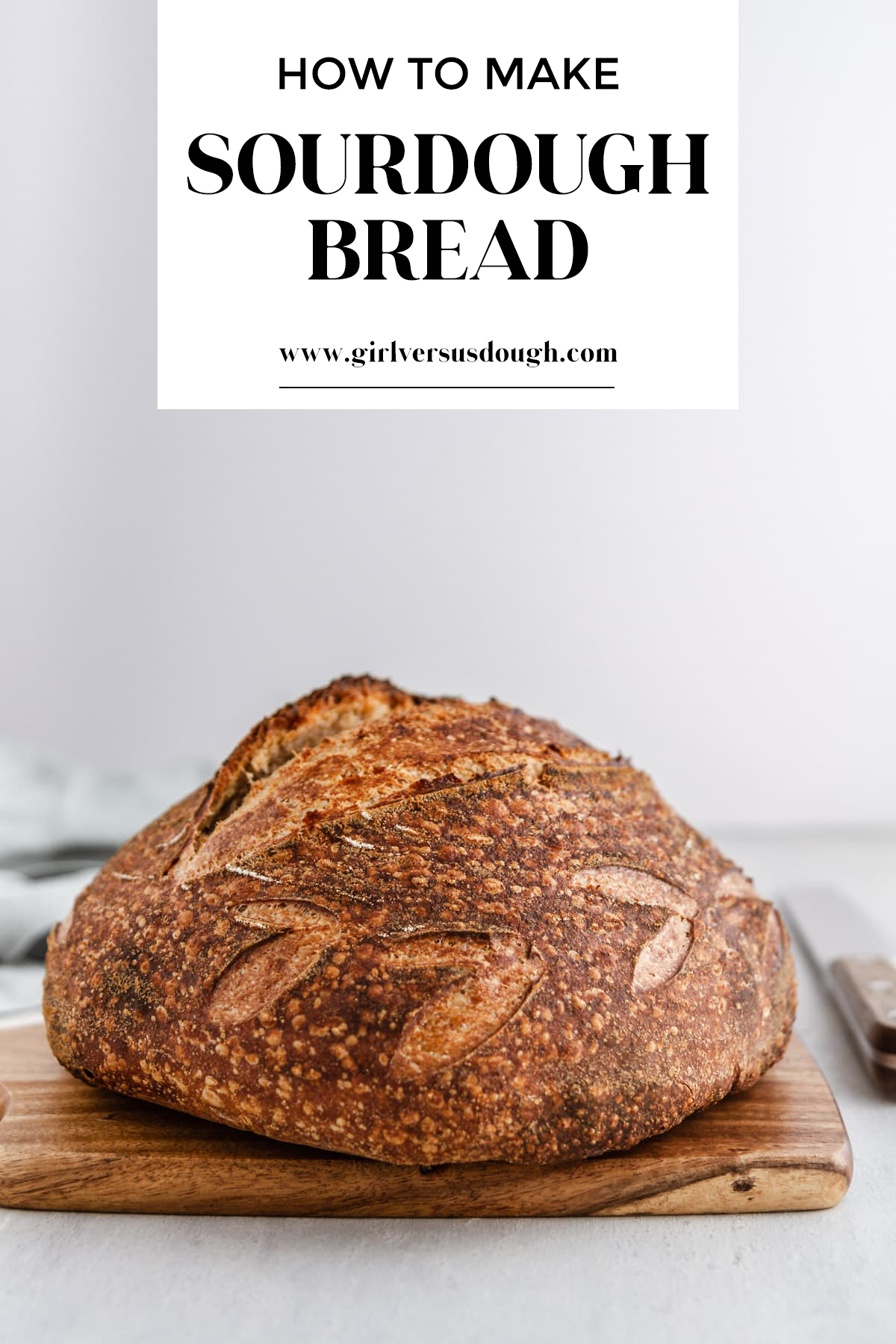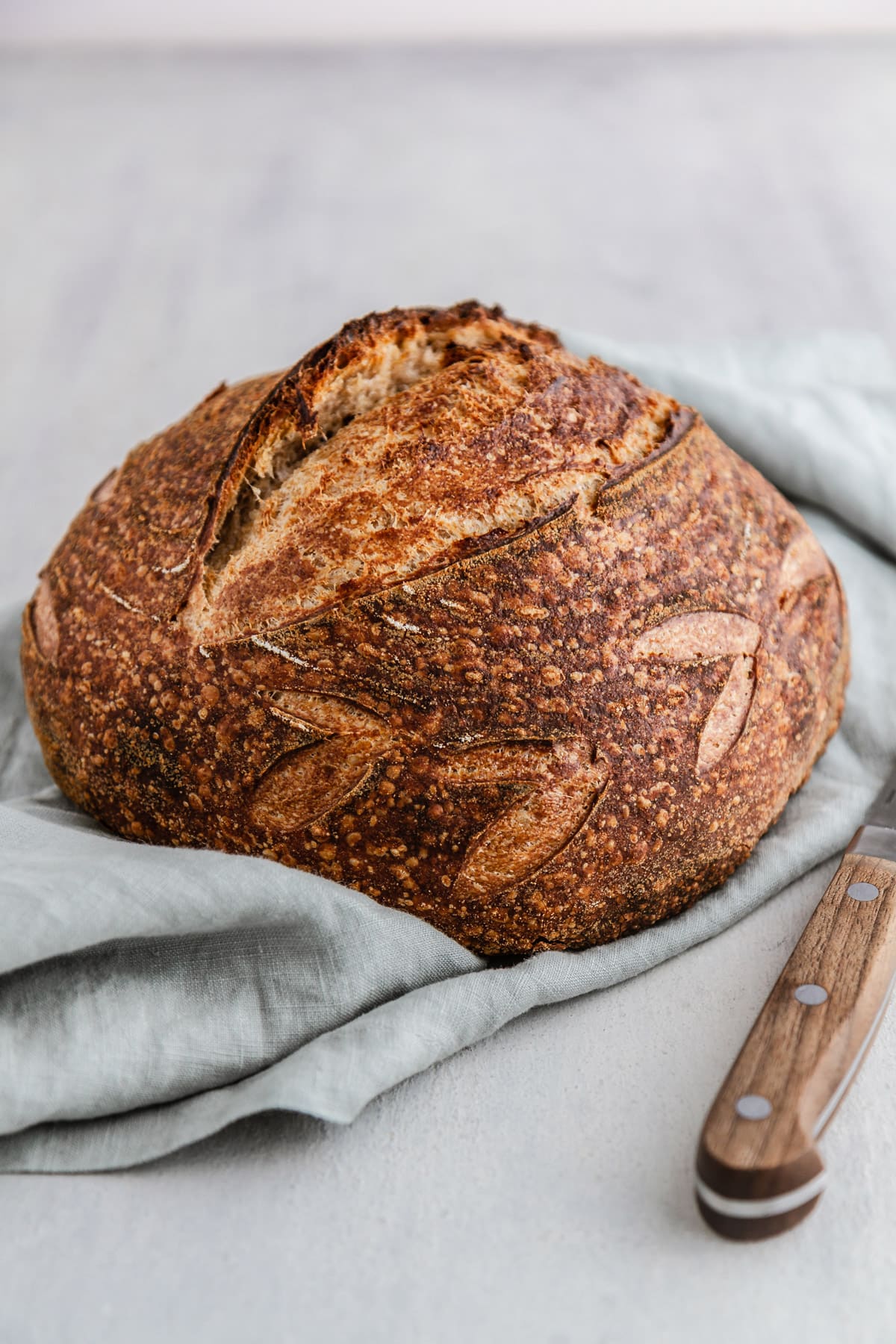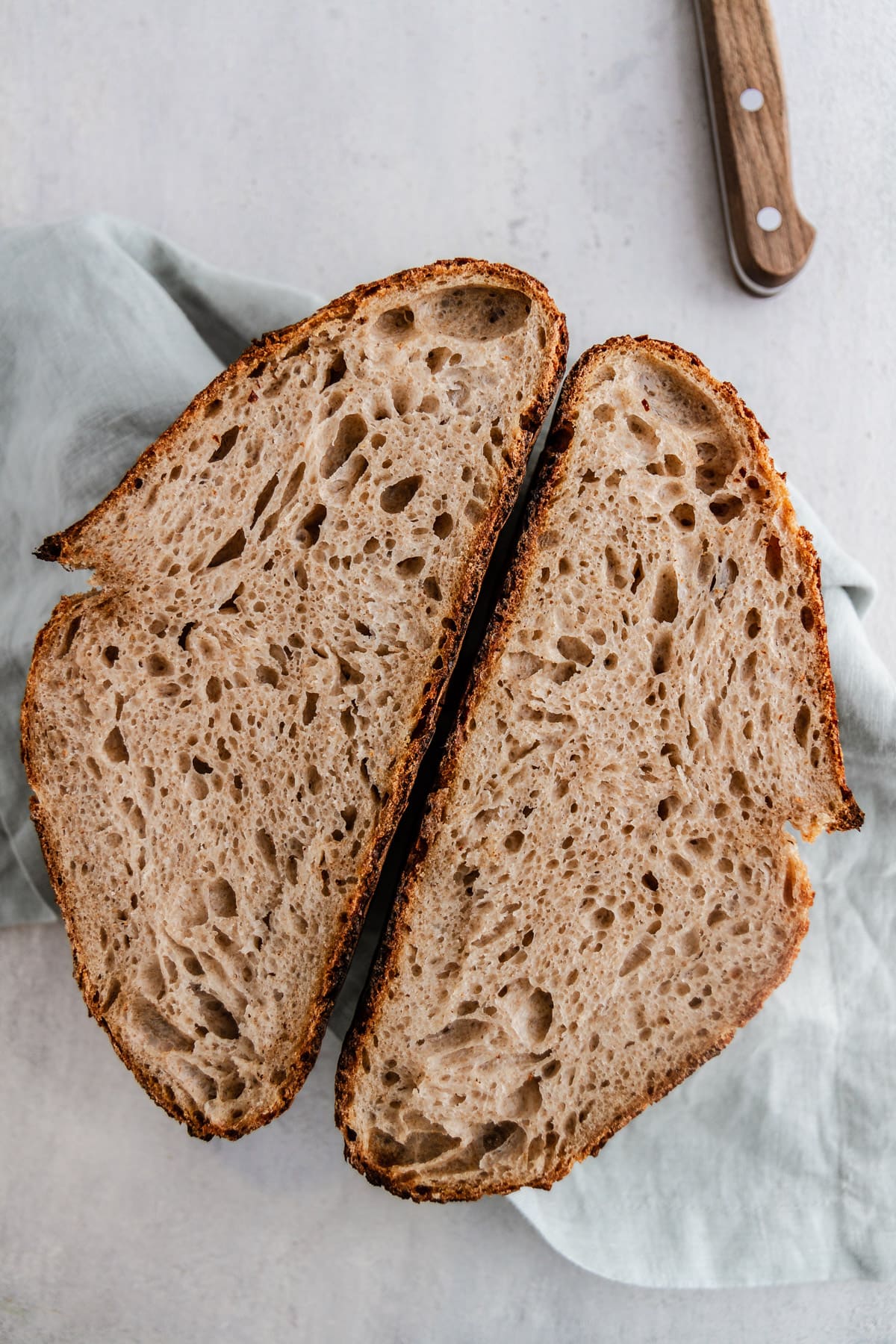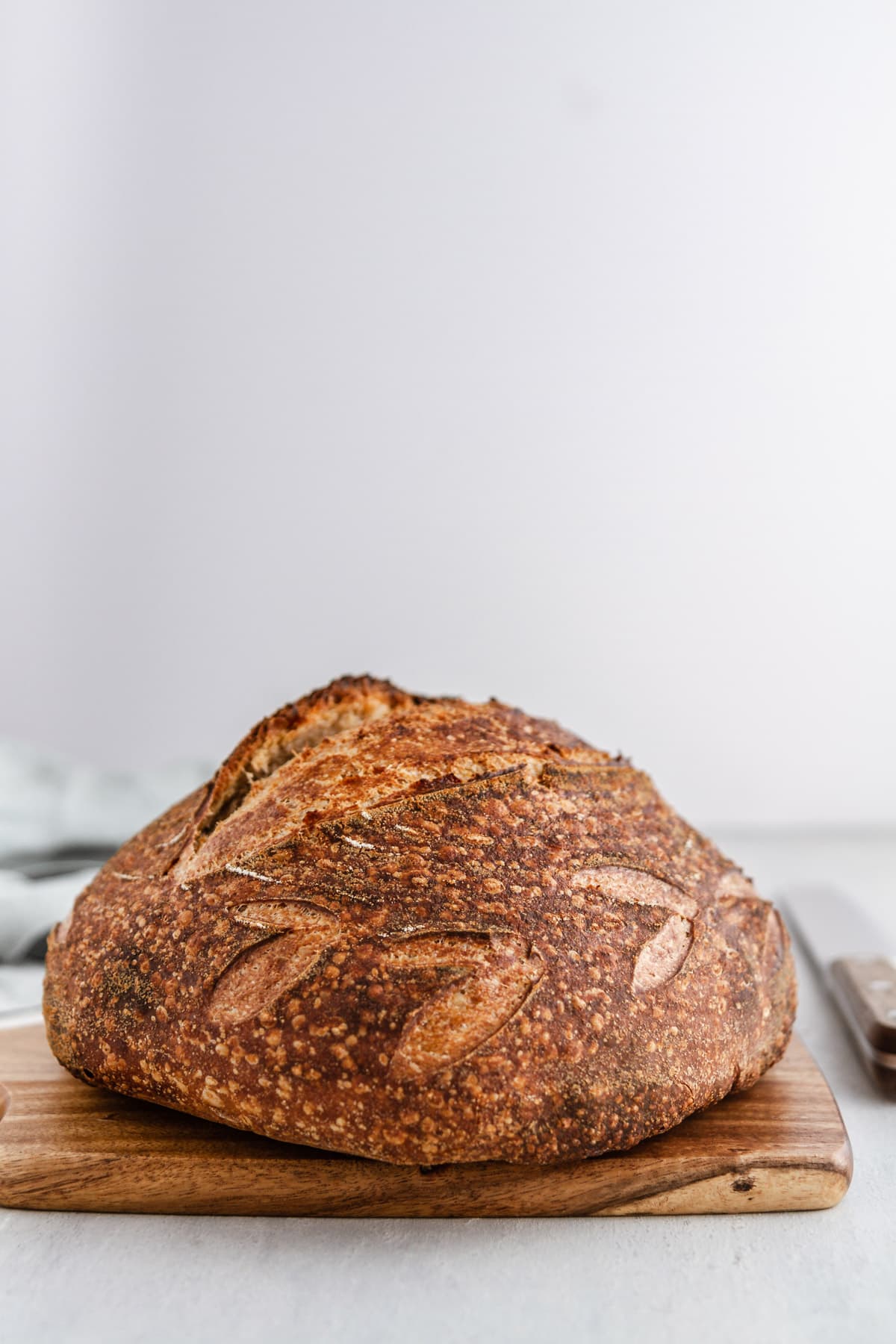introducing: how to make sourdough bread

Weeee! Friends, pardon my ridiculous enthusiasm, but today is a day I’ve been waiting for for a long, long while. I’m here on this snowy Sunday to introduce you to a new, two-week series I am posting on Girl Versus Dough titled: How to Make Sourdough Bread. I hope you are as eager to learn as I am to teach you all about sourdough bread from starter to loaf. Let’s get baking!
Today has literally been years in the making. For a very long time, I’ve been wanting to create an in-depth series on how to make sourdough bread from scratch — like, the kind that is formed entirely from wild yeast, looks like artisan bread and tastes like the kind of bread you get from a bakery but you bake it AT HOME. I’m here to take you by the hand and help you every step of the way until you, too, have a beautiful baked loaf of sourdough in your own kitchen. It’s possible, and you CAN do it. I totally believe in you.

HOW TO MAKE SOURDOUGH BREAD: WHAT TO EXPECT FROM THIS SERIES
Let me break down this series for you:
First, you get the rundown of my essential sourdough tools, complete with a printable checklist to help you gather everything you need for the best sourdough bread of your life.
Second, I share my step-by-step guide on how to make a sourdough starter in one week, also with a printable guide that gives you the full feeding schedule so you don’t miss a single feeding.
Third, I share my step-by-step guide on how to make my favorite sourdough bread recipe, from starter to loaf.
And finally, I conclude with a post in Q&A format sharing my best sourdough baking tips and resources that have helped me in my sourdough baking journey.

STAY UP TO DATE ON HOW TO MAKE SOURDOUGH BREAD
You may have followed along on my #GVDsourdough adventures on Instagram, and if you haven’t, I highly suggest you follow along in the Stories Highlights as we move through this series. I have several tips and tricks and guides on there as bonus content to help you visualize and wrap your mind around the whole idea of sourdough.
ALSO, use the tag #GVDsourdough when sharing your sourdough posts so I can see what you’re up to! This would make my life.
Of course, if you have any questions along the way, please reach out! Leave a comment, send me an e-mail, message me on Instagram or Facebook. I would love to know what you’re most interested in learning about sourdough, what issues you’ve faced if you’ve ever tried making it before, what certain terms mean (like autolyse and hydration and bulk fermentation, WHAT. Don’t worry, I will tell you everything!), how your own sourdough journey is going as you follow along. I am here for you!

Finally, to stay the most up-to-date on the How to Make Sourdough Bread series, be sure to sign up for my e-mail list, if you haven’t already. That way you’ll get the posts sent to your inbox the day they go live.
I think that covers everything? OMG, OK. Let’s do this.
TO GET STARTED, head to my first post: Essential Sourdough Tools.
P.S. Want to get started on baking bread immediately? I get you. Give my No-Knead Dutch Oven Bread a try for a shortcut version of artisan bread that’s so yummy.

I’m looking forward to your posts over the next coming weeks. I have been playing with sourdough for quite some time, but don’t do it enough to become proficient in the bread making aspect. I use my starter at least once a week to make pizza dough. As far as the bread goes, I’ve found it very easy once you learn the methods. Tweaking percentages and using different types of flour makes it even more interesting. Give me a loaf right out of the oven along with a jar of Nutella and I’ll be satisfied for hours!
Jeffrey, I agree it’s easy once you get the hang of it! Like riding a bike. 😉 And Nutella, YES to that.
Although I’ve baked bread most of my adult life, I’ve never made sour dough bread and shied away from it because I thought it would have a sharp tang to it.
So I’m looking forward to following your lessons on FB. I’m already receiving your emails as well.
Michele, I hope you love the series and find the flavor from this process as tasty as I do! 🙂
Looking forward to this! I’ve been thinking a lot about sour dough bread since watching Michael Pollan’s fabulous ‘Air’ episode of Cooked.
Richard, I need to see that!
Stephaine, you really do! It’s absolutely *marvelous* and beautiful and inspiring, and it’s streaming on Netflix 🙂
I can’t wait to learn. It seems like such a tedious process.
Karen, I hope I can make it seem less tedious through this series. 🙂
Yes it is crazy challenging.
I have been baking almost 6 months. Sharing the bread is heart warming. I can have a mentor who has baked for over 60 years.
Yay!! I am excited and looking forward to the next two weeks. Sourdough bread is my favorite. Sadly and embarrassingly, I gave myself food poisoning the last time I tried to make a sourdough starter and bread. My biggest problem was I didn’t know enough about the smells of the starter and used one that had gone bad. And now, eighteen years later, I can’t wait to get started again.
JoAnn, Oh no, that’s so scary! I hope this process gives you the insight you need so that doesn’t happen again!
I received the Tartine bread book from my wife as a gift last year and spent a lot of my summer baking. Excited to see how your methods and recipes compare!
Matt, I still need to get my hands on the Tartine books! They’re so lovely and I’m sure very inspiring!
Can’t wait to read the series! I’m interested to know your thoughts on stiff vs liquid starter too. Just starting my sourdough adventures and have heard differing thoughts on the two
Becky, Will add that question to the Q&A list; thank you! 🙂
What a beautiful photo of your bread! I love everything sourdough, and I really want to learn to make this. I think I would impress myself! Thanks for the clear instructions and info.
Hiya.
Just tried this recipe and there is no way, despite lots if folding, that the dough is firm enough to shape.
Any ideas what I might have done wrong.
Hi John, I’m sorry about that! It’s hard for me to know without seeing exactly how you went through the process. Have you been weighing ingredients along the way or measuring with measuring cups? My best guess is that there’s not enough flour to give the dough structure, or the gluten hasn’t developed enough strength at that point to give the bread some shape — could be worth letting it rise for longer with as many folds as needed until it develops shape.
I would love to learn how to bake such beautiful bread like yours. I received a strong, vital sourdough from one of my friends, now I feed it and observe it. Maybe next week I’ll try to prepare my first bread. I am a little scared to get started 🙂
Noemi, You can totally do it! It takes patience and practice but the rewards are so great. I believe in you! 🙂
Just found this post now and excited to dive into Sourdough as a distraction during the social distancing!
Annaliese, Ha! Yes, now is the time to make sourdough bread! 🙂
Hi Stephanie – aside from your starter rising/falling properly, what other things do you look for to tell if your starter has gone bad? Mine has been collecting liquid at the top in between feedings and the smell is very pungent – has my starter gone bad?
Kelsey, Is the smell really off-putting, or just slightly vinegary/sour? If it’s a bad odor (like makes you wince), or if the liquid that is forming on top is black or pink, then it’s gone bad. If the liquid is clear or even slightly gray, it’s OK — that just means your starter is hungry and needs to be fed.
Thanks for your knowledge and hard work.
Joe Falcone
HELP!! I’m trying your process for the first time and I just OVER fermented my dough by ONE WHOLE HOUR! It’s SOUP! Is there ANYTHING I can do to recover it? Or can I make something else with it?? I feel so bad … it was going so well up to this point.. 🙁
Cindy, At what point in the process are you? Is this your starter you’re talking about or a dough for loaves? Over-fermenting by one hour shouldn’t make your dough soupy, so it sounds like something else might have gone wrong, but unfortunately I’m not sure what unless I know at what point in the process you are! Soupy dough tends to be a result of over-fermenting by several hours, or if the ambient temperature of the room is too warm, or if you added too much liquid. If you can’t shape the dough into a ball, then you could make focaccia with it (bake it in a 9×13-inch pan). I hope that helps!